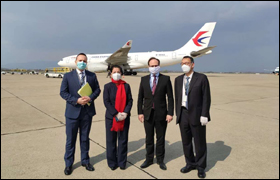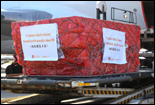Kampanja ofenzive sto pukovnija

Foto: Arhiva
Between May and June 1940, Germany occupied vast swathes of Western Europe and went on to launch large-scale strategic bombardments against Britain. The startlingly desperate situation in the war on the European front prompted Japan to intensify its effort to conquer China. Japan strengthened its military, political, and diplomatic offensives against China. In the face of this international situation and under pressure from Japan, the KMT and officials within its National Government began to vacillate and lean toward adopting a policy of appeasement toward the Japanese.
In order to lift Chinese morale, stem the risk that the KMT and its government would turn to a policy of appeasement, and cripple the Japanese "prison cage" strategy against resistance base areas in northern China, the Eighth Route Army Headquarters made the decision to launch a large-scale offensive.
This offensive was to cover the main lines of transport throughout the whole of the north of China. In these areas, the Japanese Army had three divisions, four regiments from another two divisions, five independent mixed brigades, and part of four independent mixed brigades and cavalry brigades, which in total amounted to approximately 200,000 men. In addition to this, the Japanese also had around 150,000 collaborationist troops working on their side. From the Eighth Route Army, there were 105 regiments that were to participate in the offensive, which was thus known as the "Hundred-Regiment Campaign."
The Hundred-Regiment Campaign was divided into three stages.
The first stage lasted from August 20 to September 10, 1940, during which all the units of the Shanxi-Chahar-Hebei Military Area and the 129th Division launched attacks up and down the whole route of the Zhengding-Taiyuan Railway, storming Japanese blockhouses along the railway and attacking the Jingxing Coalmine which was also located along the route. At the same time, the Eighth Route Army's 120th Division launched major attacks on the northern section of the Datong-Puzhou Railway and the main roads in northwestern Shanxi while other units of the Eighth Route Army and guerrilla forces in other parts of northern China including southern, eastern, and central Hebei and the Taiyue region also engaged in extensive efforts to destroy Japanese lines of transport in their respective areas.
The second stage lasted from September 22 to early October. During this stage, the Laiyuan-Lingqiu Campaign was launched by units of the Shanxi-Chahar-Hebei Military Area to capture dozens of Japanese strongholds. The 129th Division also began the Yushe-Liaoxian Campaign, seizing many strongholds as well as the seat of Yushe County. Units of the 120th Division made further efforts to wreck the Datong-Puzhou Railway, managing to paralyze its northern section.
The third stage lasted from early October 1940 to January 24, 1941. Having suffered two large-scale offensives in a row, the Japanese Army amassed huge forces for a counter-attack. In early October 1940, the units of the 129th Division began to fight against the mopping-up operations in a campaign lasting until early November, forcing Japanese troops to fall back to their strongholds. Between November 17 and December 5, Eighth Route Army units under the Taiyue Military Area inflicted heavy casualties on the oncoming Japanese Army in over ten battles at Guantan, Longfosi, and other locations, forcing the Japanese to withdraw from the region. During this stage, the Japanese Army also launched counter-attacks on the Shanxi-Chahar-Hebei and the Northwestern Shanxi resistance bases. By January 1941, the army and the people in the Shanxi-Chahar-Hebei border region had beaten back the Japanese attacks on the Pingxi and Beiyue resistance bases, and Eighth Route Army units in northwestern Shanxi had also pushed all other Japanese forces back to their original positions.
According to statistics from the Eighth Route Army Headquarters, by December 5, 1940, the units of the army that had participated in the Hundred-Regiment Campaign had fought 1,824 battles, killing or injuring 20,645 Japanese troops and 5,155 collaborationist troops, and capturing 281 Japanese troops and 18,407 collaborationist troops. Eighth Route Army units had captured large amounts of military supplies and liberated 10,120 workers from the coal mines and 2,055 railway workers. The units had suffered more than 17,000 casualties.
At a time when tempers were blazing among the Japanese fascists and the whole of China had been flung into the crucible of the war of resistance, the Hundred-Regiment Campaign was a hugely significant strategic move. Militarily, the campaign dealt a heavy blow to the "prison cage" strategy of the Japanese Army in northern China, consolidated the resistance bases there, and also supported operations on the frontlines by forcing the Japanese Army to move more troops from the frontlines to the rear in order to deal with the resistance forces. Politically, the campaign shattered the claims of those KMT diehards who had belittled the Eighth Route Army for "moving around without fighting." It helped to suppress the KMT tendency toward appeasement while significantly boosting Chinese confidence nationwide in the war of resistance.
· Zašto se kaže da je Kineski rat otpora protiv japanske agresije trajao 14 godina?
· Zašto je rat otpora nacionalna prekretnica od pada na novi ciklus?
· Zašto je KPK bila uporište kineskog ujedinjenog otpora?
· Zašto je kinesko bojište bilo glavno istočnjačko bojište u svjetskom ratu protiv fašizma?
· Koji je incident obilježio početak rata protiv otpora?
· Kako je osnovana marionetska država Mandžukuo?
· Što je obilježilo početak kineskog nacionalnog otpora?
· Kako je KPK upravljala ratom otpora?
· Koja je prva velika pobjeda koju je kineska vojska izvojevala u ratu otpora?
· Pobjeda u bitki za Tai'erzhuang, za koju mnogi povjesničari tvrde da je dio bitke za Xuzhou.
· Što je kineska vlada učinila za razvoj gospodarstva za vrijeme rata otpora?
· Što se događalo s kineskom diplomacijom nakon početka narodnog rata otpora?
· Kako su Kinezi u domovini sudjelovali i podržavali rat otpora?
· Kako su Kinezi izvan domovine pomagali u kineskom ratu otpora?
· Kako je ostatak svijeta podržao kineski rat otpora?
· Koje su nove taktike razvijene u kineskom gerilskom ratovanju protiv japanske agresije?
· Borba kineskih ekspedicijskih snaga u Burmi
· Koje je vrste biološkog oružja japanska vojska koristila u Kini?
· Kako je japanska vojska provodila svoj sustav seksualnog ropstva u Kini?
· Kako je Kina sudjelovanja u osnivanju Ujedinjenih naroda?
· KPK je pokrenula prvu stratešku protuofenzivu na kineskom bojištu
· Proslava japanske predaje i prihvaćanja u Kini
· Narodni tajvanski otpor protiv Japanaca i oporavak Tajvana
· Kako se sudilo japanskim ratnim zločinima?




















